Introduction
In the rapidly advancing field of industrial automation, the need for accurate and reliable sensors is more critical than ever. Telemecanique, a trusted brand, offers a comprehensive range of photoelectric sensors designed to meet various industrial needs. In this blog, we will explore the different types of Telemecanique photoelectric sensors, highlighting their unique features and diverse applications.
Understanding Telemecanique Photoelectric Sensors
Telemecanique photoelectric sensors are devices that detect objects, changes in surface conditions, or environmental changes through the use of light. These sensors are pivotal in ensuring the efficiency and safety of automated processes. Let’s delve into the types of Telemecanique photoelectric sensors and understand their specific uses.
Types of Telemecanique Photoelectric Sensors
- General Purpose Sensors
General purpose sensors from Telemecanique are versatile and cover a broad range of detection methods:- Diffuse Mode: This mode is used for detecting objects directly in front of the sensor. It’s ideal for applications requiring short-range detection.
- Background Suppression (BGS): BGS sensors are designed to ignore background objects, focusing solely on the target. This makes them suitable for environments with complex backgrounds.
- Polarized Reflex: These sensors use a reflector to detect objects, which is beneficial when dealing with objects of varying colors and finishes.
- Through-Beam Detection: Consisting of an emitter and a receiver placed opposite each other, through-beam sensors detect objects that interrupt the light beam. This mode offers the longest detection range and is highly reliable in harsh conditions.
- Laser Sensors
Laser sensors provide pinpoint accuracy and are perfect for applications requiring fine detection and measurement. Their narrow and precise laser beam allows for the detection of small objects or objects positioned at a considerable distance. - Fork and Frame Sensors
- Fork Sensors: These sensors are designed for reliable detection in tight spaces, making them ideal for applications with limited installation space.
- Frame Sensors: Frame sensors excel at detecting irregularly shaped objects, such as those on a conveyor belt, ensuring consistent and accurate detection.
- Specific Applications Sensors
Telemecanique offers sensors tailored for unique scenarios, ensuring optimal performance. These include sensors designed for high-speed detection, harsh environments, and those that need to detect transparent or reflective objects.

Features of Telemecanique Photoelectric Sensors
- Premium Build: Crafted from high-quality materials, these sensors ensure durability and longevity, even in demanding industrial environments.
- Multiple Modes: Users can choose from various detection modes such as diffuse mode, through-beam, or background suppression, providing flexibility in deployment.
- Wiring Options: These sensors are available with different wiring configurations, including 3-wire or 4-wire setups, NPN or PNP output types, and relay outputs, making them adaptable to various control systems.
Applications of Telemecanique Photoelectric Sensors
- Material Handling
Telemecanique sensors are essential in conveyor systems, packaging lines, and assembly processes. They detect the presence, absence, or position of objects, facilitating automated sorting, counting, and quality control. - Elevators and Escalators
These sensors monitor door positions, car leveling, and emergency stop conditions in elevators and escalators, enhancing safety and efficiency by detecting obstructions and controlling movements. - Food and Beverage Industry
In food processing and packaging, Telemecanique sensors detect packaging materials, labels, and product positioning. Their ability to withstand washdowns and high temperatures makes them ideal for this industry. - Automotive Manufacturing
Used for part detection, assembly line automation, and quality control, Telemecanique sensors enhance production efficiency and safety in automotive manufacturing by ensuring correct positioning and assembly of parts and preventing defects.
Conclusion
Telemecanique photoelectric sensors are integral to modern automation, offering precise detection solutions across various industries. From general-purpose sensors to specialized options for unique applications, Telemecanique provides a wide range of products designed to enhance efficiency and safety. By incorporating these sensors into your processes, you can optimize operations and ensure reliable performance. Explore the diverse types of Telemecanique photoelectric sensors and elevate your automation systems today.


Your writing is not only informative but also incredibly inspiring. You have a knack for sparking curiosity and encouraging critical thinking. Thank you for being such a positive influence!